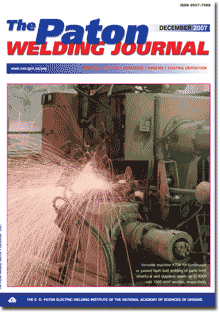

| SCIENTIFIC AND TECHNICAL | |||||||||||||||||||||||||||||||||||||||||||||||||||||||||
| Makhnenko V.I., Velikoivanenko E.A. and Semyonov A.P. Method for evaluation of fracture toughness of welded assemblies by combining mathematical modelling and measurements on small-section specimens | 2 | ||||||||||||||||||||||||||||||||||||||||||||||||||||||||
The improved method, being an outgrowth of the B.Z.Margolin method for evaluation of fracture toughness of structural steels through a more exact modelling of deformation processes within the crack zone of a test specimen, is suggested for plotting the KIC versus temperature probability curves for specimens of embrittled steel 15Kh2NMFA, 50 mm thick, based on the results of testing 10 mm thick specimens at a temperature of Д100 °C.
| Kharlamov M.Yu., Krivtsun I.V., Korzhik V.N., Petrov S.V. and Demianov A.I. Mathematical model of arc plasma generated by plasmatron with anode wire | 9 |
Mathematical model has been developed, describing turbulent flow of the electric arc plasma and formation of the plasma jet under conditions of plasma-arc spraying. Detailed analysis of the effect of working parameters of a plasmatron using an anode wire and conditions of blowing about a low-turbulent plasma jet it generates with a laminar gas flow on electric parameters of the arc discharge, thermal and gas-dynamic properties of the plasma flow has been conducted on the basis of numerical modelling.
| Knysh V.V., Solovej S.A. and Kuzmenko A.Z. Kinetics of growth of non-through-thickness fatigue cracks in 03Kh20N16AG6 and 12Kh18N10T steels at different values of the coefficient of stress cycle asymmetry | 15 |
Based on experimental data kinetic diagrams of fatigue fracture of steels 03Kh20N16AG6 and 12Kh18N10T at different values of the coefficient of stress cycle asymmetry are plotted. A three-parameter kinetic equation describing the regularities of development of non-through-thickness fatigue cracks in the studied steels is proposed, and its crack resistance parameters are determined. The fatigue life values calculated on the basis of the derived equation are compared with the experimental data.
| Grabin V.F. and Golovko V.V. Effect of distribution of manganese in structural components on properties of low-alloy weld metal | 19 |
The effect of oxygen potential and alloying ability of welding fluxes on distribution of manganese in the weld metal between non-metallic inclusions MnO and solid solution Mns.s has been studied. The (MnO)/[Mns.s] ratio can be used for differential evaluation of the efficiency of alloying of the welds with manganese, allowing for a different character of its effect on strengthening of solid solution, composition of non-metallic inclusions, and structure and mechanical properties of the weld metal.
| Shishkin A.E., Shishkin E.A. and Ustinov A.I. Thermal analysis of microlaminate fillers based on intermetallic-forming elements | 23 |
Microlaminate Ni/Al fillers were used as an example to determine by the method of differential thermal analysis the temperature ranges and intensity of running of reaction diffusion processes depending on their heating rate, and evaluation of the specific amount of heat evolving at running of the reaction of high-temperature self-propagating synthesis triggered by an electric spark discharge in these materials, was performed.
| INDUSTRIAL | Kovtunenko V.A. The E.O. Paton bridge half a century later | 28 |
Presented is the information on requirements to steel, joining technologies and welding equipment specified by designers for fabrication of an all-welded road bridge. The forthcoming reconstruction of the bridge is based on up-to-date achievements of metallurgy and welding engineering.
| Granovsky N.A., Timchenko V.V., Ilyushenko V.M. and Butakov G.A. Two-operator machine for tig welding of copper | 30 |
Two-operator machine for TIG welding of copper in helium was developed. The machine consists of the main module (power source) and two remote modules powered by 3 Ф 36 V voltage and having a self-sufficient system of antifreeze cooling. The machine ensures an independent adjustment of welding current of each of the two stations, welding current stabilization, reliable and fast arc excitation and stable arcing in helium in copper welding.
| Chernayk Ya.P. Comparative evaluation of wear resistance of electrode materials applied for reconditioning tram rails | 33 |
Tribotechnical characteristics of metal deposited with flux-cored wires of austenitic (PP-AN202) and ferritic (PP-AN203) classes and M76 steel have been evaluated. It is established that at dry friction at metal sliding over metal the best set of service properties is found in the deposited metal of austenitic class, which is also capable of strengthening in service.
| Yushchenko K.A., Levchenko O.G., Bulat A.V., Bezushko O.N., Samojlenko V.I. and Misechko V.V. Sanitary and hygienic characteristics of covered electrode for welding high-alloy steels | 35 |
Results of investigation of hygienic characteristics of fumes formed in covered-electrode welding of high-alloy chromium-nickel steels are presented. It is shown that they are determined by the content of alloying elements in electrode rod and covering, type of electrode covering, method of deoxidising-alloying of the weld metal, and composition of a gas-slag forming base of coverings. The level of emissions and toxicity of welding fumes can be decreased by changing the above factors.
| BRIEF INFORMATION | Ilyushenko V.M., Butakov G.A. and Ganchuk A.V. Robotic station for welding globe valves in Ar + CO2 gas mixture atmosphere | 39 |
Described is a robotic station for welding globe valves, which includes a workpiece rotator. Synchronising the rotator operation with the RM-01 robot manipulator is provided by using the «Sfera-36» control system devices. The station was tested by the E.O.Paton Electric Welding Institute.
| News | 40 | Thesis for scientific degree | 41 | NEWS | Weldex/Rossvarka-2007 | 42 | Interindustry Training-Attestation Center of the E.O. Paton Electric Welding Institute of the NAS of Ukraine. ITAC Professional Training Programs for 2008 | 45 | Developed at PWI | 27 | 29 44 Index of articles for TPWJ′2007, Nos. 1–12 | 49 | List of authors | | ||||||||||||||
(You are viewing the simplified file contents)
